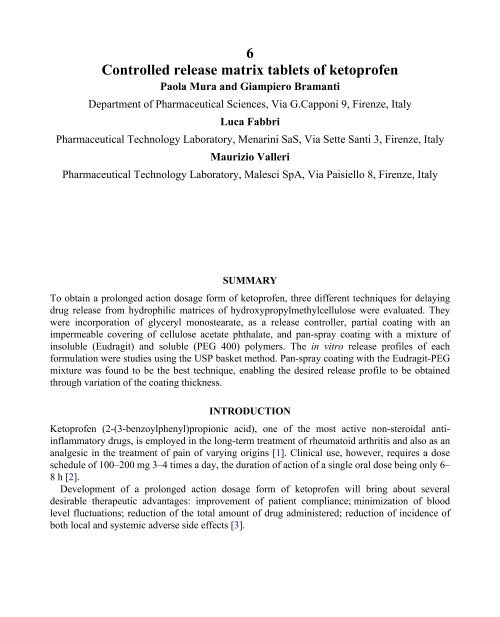Pharmaceutical Technology: Controlled Drug Release, Volume 2
Pharmaceutical Technology: Controlled Drug Release, Volume 2
Pharmaceutical Technology: Controlled Drug Release, Volume 2
Create successful ePaper yourself
Turn your PDF publications into a flip-book with our unique Google optimized e-Paper software.
6<br />
<strong>Controlled</strong> release matrix tablets of ketoprofen<br />
Paola Mura and Giampiero Bramanti<br />
Department of <strong>Pharmaceutical</strong> Sciences, Via G.Capponi 9, Firenze, Italy<br />
Luca Fabbri<br />
<strong>Pharmaceutical</strong> <strong>Technology</strong> Laboratory, Menarini SaS, Via Sette Santi 3, Firenze, Italy<br />
Maurizio Valleri<br />
<strong>Pharmaceutical</strong> <strong>Technology</strong> Laboratory, Malesci SpA, Via Paisiello 8, Firenze, Italy<br />
SUMMARY<br />
To obtain a prolonged action dosage form of ketoprofen, three different techniques for delaying<br />
drug release from hydrophilic matrices of hydroxypropylmethylcellulose were evaluated. They<br />
were incorporation of glyceryl monostearate, as a release controller, partial coating with an<br />
impermeable covering of cellulose acetate phthalate, and pan-spray coating with a mixture of<br />
insoluble (Eudragit) and soluble (PEG 400) polymers. The in vitro release profiles of each<br />
formulation were studies using the USP basket method. Pan-spray coating with the Eudragit-PEG<br />
mixture was found to be the best technique, enabling the desired release profile to be obtained<br />
through variation of the coating thickness.<br />
INTRODUCTION<br />
Ketoprofen (2-(3-benzoylphenyl)propionic acid), one of the most active non-steroidal antiinflammatory<br />
drugs, is employed in the long-term treatment of rheumatoid arthritis and also as an<br />
analgesic in the treatment of pain of varying origins [1]. Clinical use, however, requires a dose<br />
schedule of 100–200 mg 3–4 times a day, the duration of action of a single oral dose being only 6–<br />
8 h [2].<br />
Development of a prolonged action dosage form of ketoprofen will bring about several<br />
desirable therapeutic advantages: improvement of patient compliance; minimization of blood<br />
level fluctuations; reduction of the total amount of drug administered; reduction of incidence of<br />
both local and systemic adverse side effects [3].

















